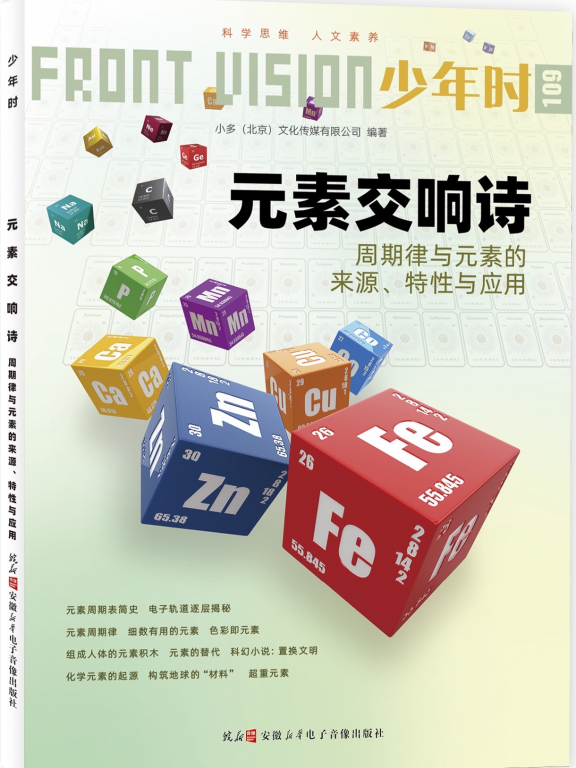This article appears in “Symphony of the Elements,” the January 2024 issue of Front Vision, an educational Chinese-language magazine for kids. It is reproduced here with permission.
Color and the elements
by Kathryn Hulick
A pale red and yellow rug, a blue shirt, a green jade figurine – what different colors do you see when you look around? Most of the colors in our clothing and other artificial items come from dyes and pigments, just like the pigments that color a set of paints or a box of crayons. Many parts of the natural world have stunning colors, too. Flowers and animals come in a rainbow of shades. Gemstones are colorful, too: Jade is often green, rubies are usually red, amber is typically yellow, and amethyst is purple.
Artificial and natural colors happen because of the way light interacts with different materials. Sometimes, a material has tiny structures or shapes that reflect certain types of light. This is called structural color – it’s what makes a soap bubble or a butterfly’s wings appear shiny and iridescent. For example, the tiny scales on the wings of a blue morpho butterfly are covered with tree-like nanostructures. The spacing of the branches on these trees amplifies any blue light that hits them.
The color of a paint pigment or a fresh, green piece of broccoli, though, comes from chemistry, not structure. To understand where the color of these things comes from, you need to know the elements that make up the material.
Many paint pigments, including cobalt blue, cadmium red, and manganese violet, are named after some of the elements that they contain, Similarly, gemstones get their color from the elements inside them. A pure sample of the mineral corundum is transparent. However, when the mineral contains traces of chromium atoms, it becomes a red ruby. When it contains traces of titanium, it becomes a blue sapphire.
The chemical elements dictate what types of light a material will absorb or emit. And that determines what color the material will appear.
What’s in a Sunbeam?
When you mix a bunch of paint colors together, they turn brown or black. Mixing colors of light together, though, gives you white. A beam of bright white sunlight contains all the colors we can see, all jumbled together.
Visible light is a form of electromagnetic radiation, a type of energy that makes up all sorts of different types of signals, including radio waves, which have wavelengths of several meters, and X-rays, which have wavelengths the size of a single atom. Human eyes see the colors of light ranging from wavelengths of around 380 nanometers (violet) to around 700 nanometers (red). The shorter the wavelength of light, the more energy that light contains, so violet light has more energy than red light.
Broccoli looks green because its molecules contain the natural pigment chlorophyll, which absorbs blue and red light while reflecting green. A T-shirt appears blue because its dye reflects blue wavelengths of light while absorbing the other wavelengths.
Spectroscopy is a technique that measures precisely which wavelengths of light a material is absorbing or emitting. One type of absorption spectrum graph shows the wavelengths of absorbed light as spikes. Most plants contain two varieties of the pigment chlorophyll, a and b. The spikes for both show up in the blue and red parts of the rainbow. Both types absorb almost no green at all, so that’s the color most plants appear.
When astronomers want to know what a star or other celestial body is made of, they use spectroscopy to investigate light. Each chemical element has a unique spectrum. Hydrogen, for example, absorbs light at four specific wavelengths: 410 nm (violet), 434 nm (blue), 486 nm (blue-green), and 656 nm (red). An absorption spectrum of hydrogen looks like a rainbow with colors missing at these four places. Hydrogen can also glow and give off light. This light will have an emission spectrum that’s the exact inverse, with lines of color at those four specific wavelengths.
Elemental Fingerprints
Every element has its own unique pattern of spectral lines. To scientists, this is like a fingerprint that reveals the presence of an element in a material. But where do the lines come from? To understand that, we need to look a bit deeper, at the atoms that make up an element.
Hydrogen is the simplest element, with a single electron orbiting its nucleus. This electron normally hangs out in a low energy state. Light can excite the electron into jumping into a higher energy state. However, the electron can only jump to a few very specific levels of energy, sort of like climbing on rungs on a ladder. Just as you can’t step anywhere without a rung, an electron can’t jump partway from level to level. So it will only jump when light with just the right amount of energy—meaning just the right wavelength, or color, hits it. Scientists call this the resonant energy.
For a hydrogen electron, There are four different visible wavelengths that trigger a jump. The shortest wavelength, 410 nm (violet), has the most energy, and causes the electron to jump up four levels. Light at 434 nm (blue) causes it to jump up 3 levels, 486 nm (blue-green) causes a jump of 2 levels, and 656 nm (red) causes a jump of a single level.
Electrons don’t stay in these high energy states. They soon drop back down to a lower energy level. When that happens, they give off light in the exact wavelength that they absorbed. So hydrogen electrons falling 4 levels give off 410 nm (violet) light, those falling 3 levels give off 434 nm (blue) light, and so on down the ladder.
This is only true of hydrogen when it exists as separate atoms. A chemist can atomize hydrogen and excite it, then use diffraction to make those visible wavelengths appear. Without diffraction, the different wavelengths combine together to glow with a pinkish colored light.
Normally, though, atoms of hydrogen join together into molecules of H2. Combining to form a molecule changes how electrons are arranged, and how they can move on the rungs of the ladder. “The molecule [H2] does not absorb any visible-energy light. It requires a higher energy (UV) to be excited, » explains Michael Shatruk. He is a chemist at Florida State University. That means H2 doesn’t emit any visible light, either. So hydrogen gas appears colorless to our eyes.
A complex material like paint or a piece of broccoli is made of molecules with many electrons in many orbits. The color we see depends on complex interactions in the way the electrons of all of these molecules are absorbing light. Also, light that is absorbed doesn’t always get emitted again as a visible beam. It’s often emitted as heat instead. Or the energy may get used in chemical reactions. When chlorophyll absorbs blue and red light, for example, many of the excited electrons get used to power photosynthesis, the process plants use to make food from sunlight. So we only see the green light that the chlorophyll molecules could not absorb.
Brilliant Fireworks
Have you ever wondered where the brilliant colors of fireworks come from? “It all comes down to which element is being used,” explains Kate Mullaugh, a chemist at the College of Charleston in South Carolina. The heat of a firework’s explosion excites the electrons in the atoms of a material into a higher energy state. Most elements and molecules have more than one electron, and these electrons are nested inside shells. The electrons in the outermost shell get excited. As these electrons fall back down the rungs of the ladder, they give off light. The wavelength of that light, of course, depends on how far the electron jumped. Each element is structured with a different number of shells, and therefore different distances that electrons are able to jump. These distances correspond to wavelengths of light.
Remember that short wavelengths of light like blue and purple contain more energy. So electrons need to jump more levels to emit those colors. Mullaugh explains: “Elements with big spacing between the energy levels will emit shorter wavelengths of light (which tend to be bluish or purple), and smaller spacing results in longer wavelengths of light (which tend to be orange or red). The color is the element’s fingerprint.”
You don’t need to set off fireworks to use color to identify elements. A flame test will work just fine. This is a common chemistry class experiment in which burning a material changes the color of a flame. A fire burns with lots of different wavelengths of energy all at once. Some of these wavelengths will have just the right energy to excite electrons in the target material.
The colors are the same whether you’re making a small flame or a big firework. The element barium produces bright green. Sodium makes yellow; strontium explodes with red; copper produces blue-green; potassium turns violet. Those are just a few examples. The colors of LEDs or lasers are also linked to certain elements. Gallium arsenide is in red LEDs and gallium nitride is in blue ones. Experts in pyrotechnics and lighting combine elements to make even more colors. Mullaugh says, “Fireworks are a great example of how science and art intersect – and how science brings beauty into our lives.”
From Health Tests to Cooked Broccoli
Because color reveals information about the underlying chemistry of a material, color and color changes are very useful in science and engineering.
Many sensors used in science and health change color to indicate the presence of a substance, such as a toxin or disease. If you’ve taken an at-home test for COVID-19, you’ve looked for whether a line appears on a strip of paper. This is a chromatography strip. Lighter molecules travel farther down the paper. The liquid used in the test contains dyed molecules that will bind to the virus, if it’s present. When they bind to the virus, that makes a new, heavy molecule that doesn’t travel very far down the strip before getting stuck and spreading its dye.
Spectroscopy is a very important part of astronomy because it reveals the elements that make up distant stars and many other important features of the universe. Astronomers are beginning to use spectroscopy to identify the elements present in the atmospheres of planets orbiting other stars, called exoplanets. This could help reveal which planets could be homes to alien life.
In art history, spectroscopy can reveal the type of paint an artist used. In 2016, art conservationist Jamie Martin discovered a pigment called Red 170 in a painting that was supposedly by the famous artist Jackson Pollock. In fact, this pigment was invented after the artist’s death. So the painting had to be a fake.
Even cooks rely on color chemistry! Remember that chlorophyll is what makes plants appear green. Chlorophyll is a complex molecule that contains magnesium. When you drop bright green raw broccoli into boiling water, hydrogen starts replacing the magnesium. This makes the broccoli’s color duller and browner… until it’s over-cooked. On the other hand, the distinctive brown of baked bread or cooked meat comes from the Maillard reaction. This chemical reaction reduces sugars into melanoidins, which are brown-colored polymers. So a color change can help a cook know when a meal is done.
With the help of light, the elements color our world.

